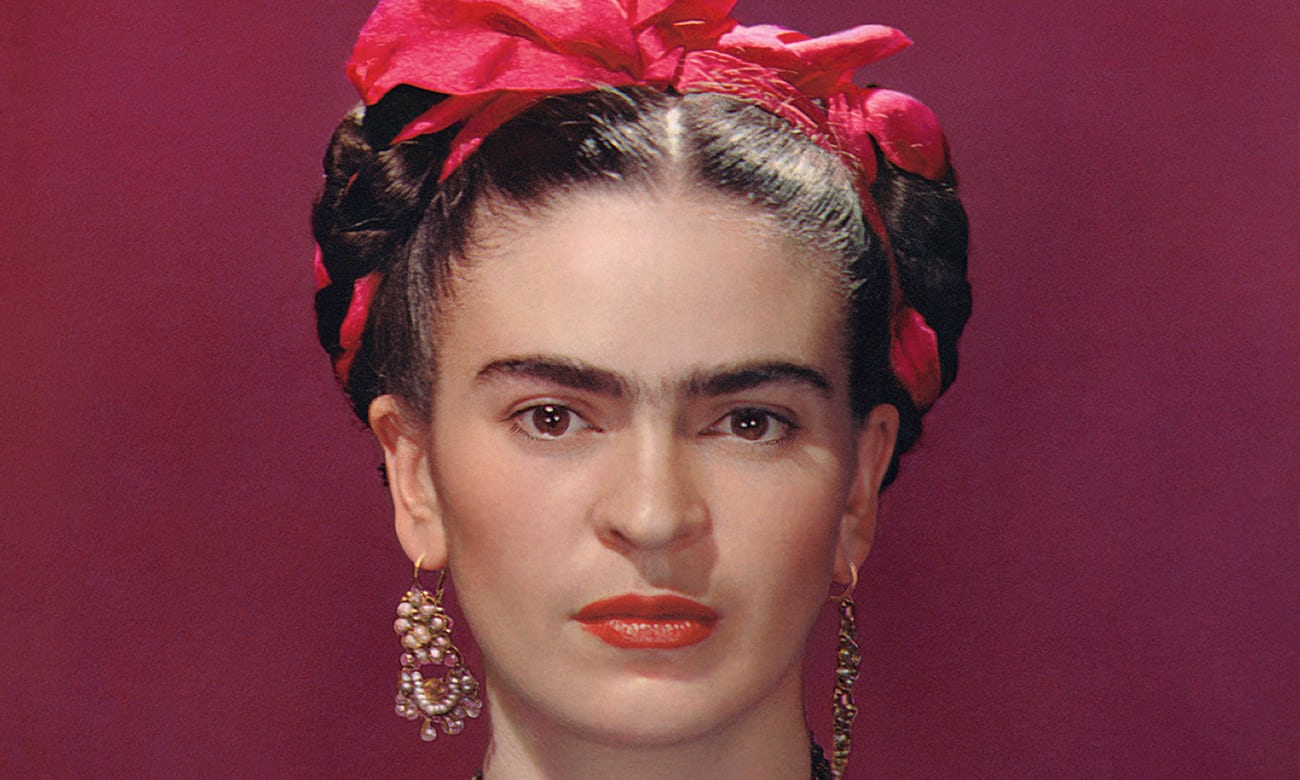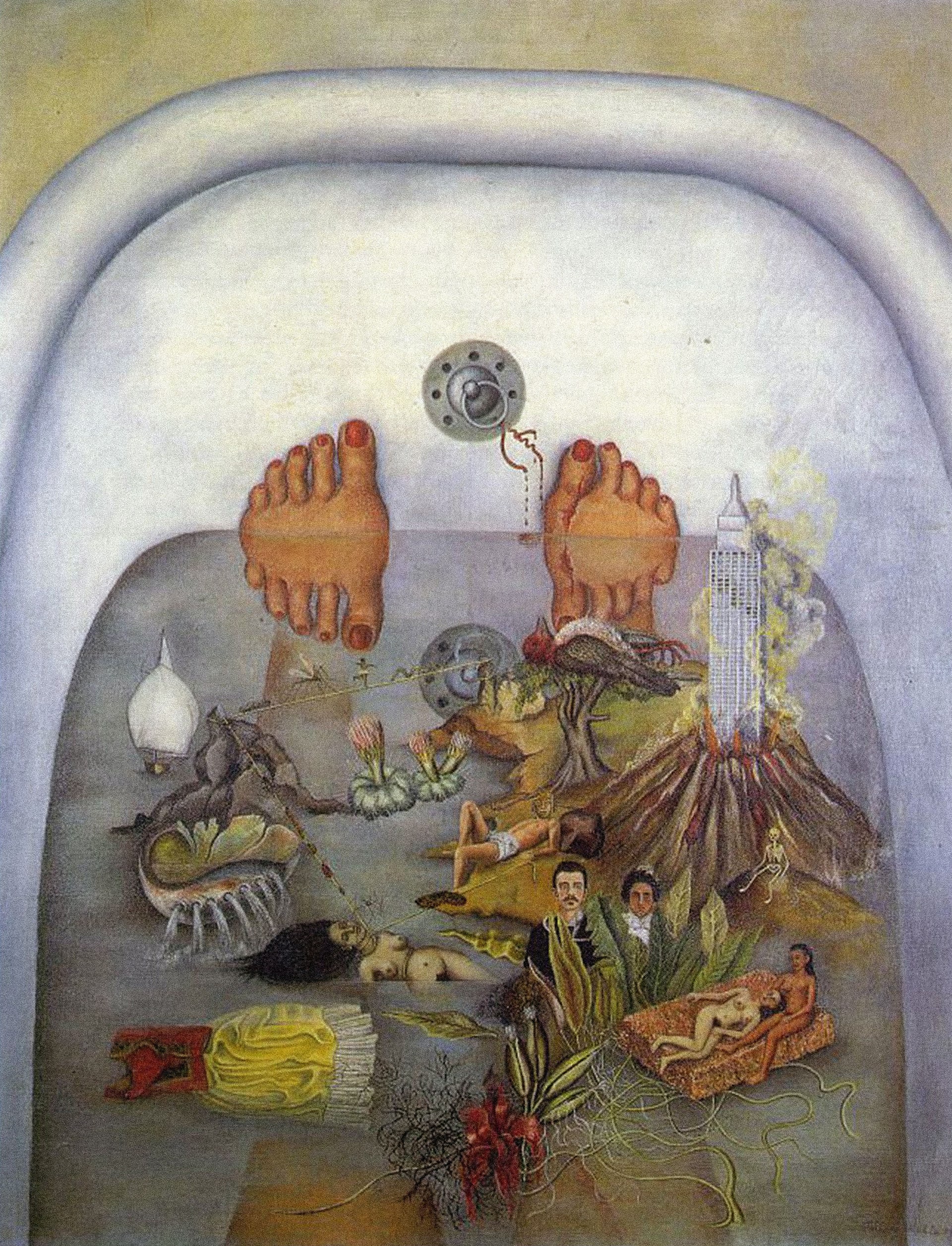The Guardian – Bitch. Sauvage. Icon. Barbie doll: the grotesque exploitation of Frida Kahlo… and the artist behind the myths.
Frida, the unapologetic bitch. Frida, the disabled artist. Frida, symbol of radical feminism. Frida, the victim of Diego. Frida, the chic, gender-fluid, beautiful and monstrous icon. Frida tote bags, Frida keychains, Frida T-shirts, And also, this year’s new Frida Barbie doll(no unibrow). Frida Kahlo has been subject to global scrutiny and commercial exploitation. She has been appropriated by curators, historians, artists, actors, activists, Mexican consulates, museums and Madonna.
Over the years, this avalanche has trivialised Kahlo’s work to fit a shallow “Fridolatry”. And, while some criticism has been able to counter the views that cast her as a naive, infantile, almost involuntary artist, most narratives have continued to position her as a geographically marginal painter: one more developing-world artist waiting to be “discovered”, one more voiceless subject waiting to be “translated”.
n 1938, Frida Kahlo painted Lo que el agua me dio (What the Water Gave Me), the painting perhaps responsible for launching her international career, but also her international mistranslation. In this self-portrait of sorts, we see Kahlo’s feet and calves inside a bathtub and above them, as if emanating from the steam, a collaged landscape: an erupting volcano out of which a skyscraper emerges; a dead bird resting on a tree; a strangled woman; a Tehuana dress dramatically spread out; a female couple resting on a floating cork. Kahlo was working on Lo que el agua me dio when the French surrealist André Breton arrived in Mexico for a visit. He was transfixed by it. He called Kahlo a “natural surrealist”, and in a brochure endorsing her New York debut at Julien Levy’s gallery in 1938, he wrote: “My surprise and joy were unbounded when I discovered, on my arrival in Mexico, that her work has blossomed forth, in her latest paintings, into pure surreality, despite the fact that it had been conceived without any prior knowledge whatsoever of the ideas motivating the activities of my friends and myself.”
Though “natural surrealist” was a label that helped translate Kahlo’s paintings for European and American audiences, it was one that she always rejected. To be projected as a “surrealist” in Europe helped audiences to understand her work more immediately – more palatably. She was branded as authentically Mexican, with international flair. But to be seen as a “natural surrealist” also transformed her into a kind of sauvage: unconscious of her talent, unsuspecting of her mastery. After her debut, a Time magazine critic described her work as having “the daintiness of miniatures, the vivid reds and yellows of Mexican tradition and the playfully bloody fancy of an unsentimental child.”
Kahlo was hardly unsuspecting, hardly unconscious of what she was doing and who she was. She knew how to capitalise on the elements of her private life and cultural heritage, curate them carefully, and use them to build her public persona. She was a mestizo, born in Mexico City, who had adopted a traditional Zapotec-Tehuana “look”. Her father, the German-born Carl Wilhelm “Guillermo” Kahlo, was a well-known photographer, and the family lived in a neocolonial mansion in Coyoacán, the famous Casa Azul. Kahlo was very much aware of the complex politics of selfhood she was creating and manipulating. In a 1939 photograph taken during the opening of Kahlo’s first exhibition in Paris, she is posing in front of Lo que el agua me dio. She is wearing a Tehuana dress and her unibrow is underscored with black eyeliner: Frida representing Frida. (It is unclear which one is the artwork.)
The way Kahlo’s work and persona were read in Mexico was of course very different from the way they were translated into other cultural milieux. Just as Breton had attached the category “natural surrealist” to her art and framed her work in a discourse that she herself did not embrace, many others did the same with various aspects of her public and private life.
An interesting example of this is the house and studio in Mexico City where she and Diego Rivera lived and worked during some of their most productive years in the 1930s. It was designed by Juan O’Gorman, the young architect who was then pioneering the radical architectural changes that took place in post-revolutionary Mexico City. Before the Mexican Revolution (1910-20), 19th-century neoclassical and colonial architecture dominated. French-influenced mansions across the city stood like lonely homages to a quickly decaying European noble class, and the family life of the Mexican bourgeoisie played out in the sumptuous and darkened stages of these interiors, with their heavy drapes and excessive ornamentation. But after the revolution new ideas about hygiene, ventilation, comfort, efficiency and simplicity made their way into the city. Houses, and with them daily life, were transformed radically and rapidly.
Attuned to the ideological and architectural changes taking place, the couple asked O’Gorman to design a studio and house for them. He created a space specifically for a couple of painters – at once separated and connected. The buildings were the first in Mexico designed for specific functional requirements: living, painting and showcasing work.
In 1933, a few years after Kahlo and Rivera married, they moved in. Rivera’s area was larger, with more work space. Kahlo’s was more “homely”, with a studio that could transform into a bedroom. A flight of stairs led from her studio to a rooftop, which was connected by a bridge to Rivera’s space. Beyond being a workplace, it became a space for the couple’s extramarital affairs: Rivera, with his models and secretaries; Kahlo, with certain talented and famous men, from the sculptor and designer Isamu Noguchi to Leon Trotsky. Perhaps without knowing it, O’Gorman designed a house whose function it was to allow an “open” relationship.
The house was an emblem of modernity and a kind of manifesto: a solitary example of a new functionalism in a city that was still trying to find a national architectural language that best suited its revolutionary programme. It did not encode traditional values or messages. It simply addressed the practical necessities of its dwellers, was materially efficient (primarily made of reinforced concrete), socially progressive and cheap.
With time, however, as neutral as the buildings may have been intended to be in their architecture, they ended up functioning as a site of Mexican cultural capital, especially one connected to indigenous Mexican craftsmanship. The couple were hosts to visitors who came to see their work and works-in-progress, as well as their collections of arts and crafts: Trotsky, Nelson Rockefeller, Pablo Neruda, John Dos Passos, Sergei Eisenstein, Breton.
O’Gorman gave Rivera and Kahlo a machine to live in, as Le Corbusier would have had it, but also a machine to translate in. Their home brought in foreignness as much as it served as a platform to project a particular idea of Mexico to the world. More than anything, it provided the stage for the power couple of Mexican modernity: cosmopolitan, sophisticated, well-connected and more Mexican than Mexico. The couple’s ultimate oeuvre was, of course, themselves. Kahlo and Rivera were, perhaps, Mexico’s first performance artists, and their casa-estudio was their very own gallery.
In 1934 the photographer Martin Munkacsi visited Mexico and copiously documented the house and studios. The pictures had been commissioned for Harper’s Bazaar, the New York-based fashion magazine which was directed at an upper-class female audience, mostly American but also French and British. In Harper’s July 1934 issue, a double-page spread titled “Colors of Mexico” displayed three of Munkacsi’s many photographs: one of Kahlo crossing the bridge from one house to the other; one of Rivera working in his studio; and one of Frida climbing the staircase to the roof. In the centre of the layout, there is a large photograph of the couple walking beside the cactus fence; a caption explains “Diego Rivera with Señora Freida [sic] Kahlo de Rivera before the cactus fence of their Mexico City home.”
The buildings were designed to embody a proletkult ideology, resembling a factory or industrial complex, with its visible water tanks, its exposed materials and raised supporting columns. The cacti fence surrounding the house, if seen in relation to it, added to the general industrial feeling. However, Harper’s chose the image that best decontextualised the cacti fence and thus presented it as a folkloric, decorative element. To the right of that central image appeared a series of photographs of barefooted Mexican peasants selling crafts and riding mules.
An accompanying piece written by Harry Block – a New York editor – describes his search for the perfect Mexican sandals: “All Mexico walks on huaraches (pronounced wahratchehs and meaning sandals) …” Juxtaposed with the portrait of Rivera and Kahlo – he, dressed like a European dandy, solid leather shoes included; she, wearing pointy black boots – Block’s ode to the huarache seems rather forced.
The Harper’s piece is a perfect example of how Mexico was perpetuated in such stories as a marginal space, with glimpses of modernity a rare exception to the rule. The magazine shows an utterly foreign Mexico, but in a way that also makes it easier to capture and explain to foreign audiences through its associated cliches. It is a form of translation that simplifies the complex operations that took place in the Rivera-Kahlo home.A functionalist Mexican house that showcased post-revolutionary art? Impossible! Let’s just use the picture with the cacti.
This instance of colonising narratives in cultural translations was not the end but the beginning. In 2002, Harvey Weinstein’s company distributed the film Frida, starring Salma Hayek, asked for a more-sexy Kahlo – more nudity, less unibrow – and got away with it. In a 2016 concert stunt in Mexico, Madonna pulled a Frida lookalike from the audience, said she was “so excited” to finally meet Frida, and then handed her a banana as a token.
Last Halloween, my 21-year-old niece was dragged by her friend to a New York college party. She wasn’t wearing a costume, was not really in the mood. At some point, a trio of Wonder Women stumbled in: red knee-high boots, star print bikini-bottoms, strapless tops, gold headbands fastened around long blond hair.
One of the three wonders took a long swig from a bottle and almost fell back, suddenly noticing my niece, standing behind her. She turned round and looked straight into her face. She studied it up close. Like many women in my maternal family, my niece inherited a dark, robust unibrow. The Wonder Woman finally said: “Oh my god, it’s Frida Kahlo!”.




